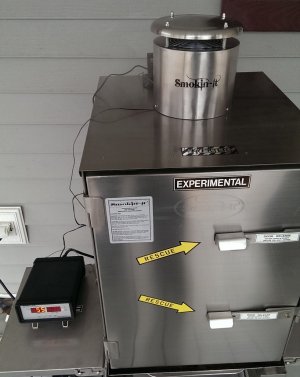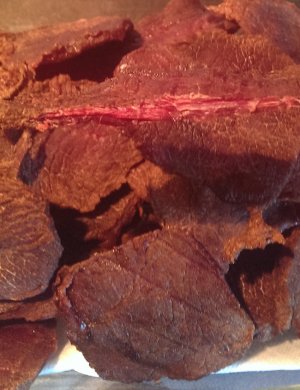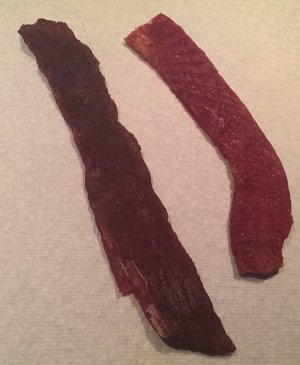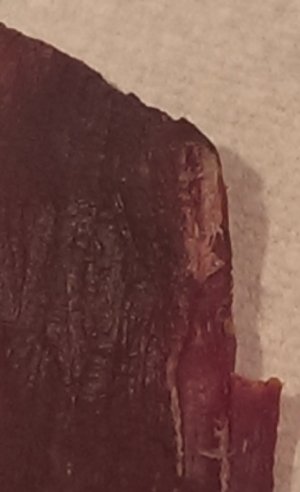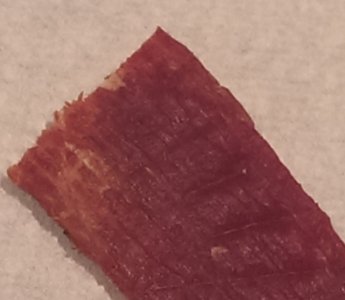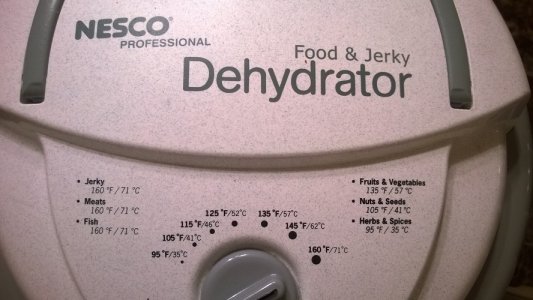DivotMaker
New member
I tried my new James dryer this weekend! I wanted a curing brine for the jerky, instead of a prepackaged dry-cure. Hey, who wants to be normal, right? I'm a big believer in the use of brines, so I knew this would be the way to go. However, researching different jerky "brines" really yielded much more results for marinades! That would be a starting point, at least.
Then, I realized that Martin (DiggingDogFarms) was a new SI owner! He has a great deal of experience with brines and cured meat, so I contacted him. Boy, I'm glad I did! He educated me on "Equilibrium Brining," and I knew immediately that it would be perfect for jerky! I will do a much more detailed post on equilibrium brining over on the Brine forum.
Here's the basics of an equilibrium brine: You can effectively calculate the salt, sugar and cure content very precisely, because the meat will never absorb more salt, cure or sugar than the calculated amount. Confused yet? The brine calculations are based on the exact weight of the meat, and the weight of the brine solution (I used 1:1 ratio). So, if the meat and solution weigh the same, the brine will diffuse into the meat and reach equilibrium with the solution! Pretty cool! I'll post some educational material in the brine post, and Martin's calculator that helps a lot!
So, for my jerky brine, I wanted a salt and sugar content of 2% each, and used 156 ppm for the cure (Martin recommended 120 ppm, since I'd be smoking it quickly, but I went with the higher cure amount to reduce brining time). The beauty of equilibrium brining is predictability and consistency. It's also very easy to adjust the results, through trial and error (taste). This is hard to do with gradient brining (what? another brining term?? Really?). I'll get into this more in the brine post, but a gradient brine is what I (and most of you) have done when you brine. You mix up a known brine, and then vary the time the meat is in the pool. This is why we brine different meats for different times. Time controls the eventual salt content. Ever heard of "over-brining?" Gradient brining is why. Over-brining is impossible with an equilibrium brine.
OK, enough science class for now - On to the Jerky!!
I decided on initial brine ingredients, more as a "starting point" for the first experimental batch, knowing they'd probably get modified! I started with 2 x 4 lb of Eye of Round Roasts from Sam's. After an hour in the freezer (should have gone 2), I trimmed the fat and sliced them to approx. 1/4" thick. I sliced one with the grain, and one across the grain (for comparison). Once it was all sliced and trimmed, I weighed the meat. I had 3631 g of meat (8 lbs). Weighing in grams for EQ brining is SO much easier! I put the slices in the fridge while I prepared my brine.
In a pan, I mixed the following:
1 cup Worcestershire sauce
1 cup low-sodium soy sauce
64 g kosher salt
9 g #1 curing salt
73 g brown sugar
2 tsp. cayenne pepper
1 Tbsp. onion powder
1 Tbsp. garlic powder
(I know you're wondering how I arrived at these amounts. I used Martin's calculator. Here's the link:
http://www.diggingdogfarm.com/page2.html
I'll go over this, in more detail, in my brine post).
I simmered this concoction on low (never to a boil) for about 20 minutes to thoroughly infuse the ingredients. Had I used real onions or garlic, or other aromatics, I would have strained the brine before mixing with the meat.
Since I knew my brine weight needed to be 3631 g (same as the meat), I knew I had room to add ice to cool the brine. I then transferred the brine to my Briner Jr., which was sitting on the scale at "tare" weight (zeroed-out). I added the brine from the pan, and water to reach 3631 g total weight.
I then submersed the meat (which just barely fit), and put it in the fridge. This was about 2 pm Saturday, and I would smoke it Sunday. The meat would be in the brine for about 17 hours, which didn't mean anything due to the controlled results of equilibrium brining!
Sunday morning:
I prepared the smoker with 3 oz of mesquite and hickory. (too much wood - I'll explain why in the results section). I also programmed the Auber to run at 130 for 30 min, and then 160 for 10 hours. At 180 and above, meat cooks. This is dryed meat, not cooked meat. I later realized that even 160 is too high.
I laid-out the slices on paper towels to remove as much brine as possible, loaded up 4 shelves for the Model 2, and headed to the smoker. I was one shelf short. The extra meat got treated a little different - more on that in a minute.
Due to placement of the Auber probe down through the shelves, I didn't do any rotation during the smoke. Switch on, and we're off and running! Smoke rolling in about 10 minutes! Meat on at 7:30 am.
I let the jerky smoke for 2 hours before starting the James Dryer. Here's where I realized 2 things: There's still LOTS of brine in the meat, even after patting dry! My drip pan was full to the top, so I had to do a quick emptying! Also, 3 oz of wood was too much, as it was still smoking at 2 hours when I put the fan in place! This caused a little temp spike as the remaining coals possibly ignited, due to the airflow introduced. Lesson: Make sure the wood stops smoking BEFORE putting the fan on! (Duh!). Next batch, no more than 1.5 - 2 oz of wood.
The leftover slices got treated to a little extra soy sauce, some liquid smoke, and a little Jim Baldridge's Secret Seasoning, then a ride in the dehydrator! Woo Hoo! The dehydrator dries meat at 145...I'd forgotten that. Hmmm. Mental note: must be a reason for that. More on that later...
After 5 hours total, I reduced the temp to 150. A few checks on the jerky, and it appeared to be coming along nicely.
At 7 hours, the jerky appeared done.
Results and Lessons:
1. The smoked jerky tasted good. Not to salty, not too sweet, and a good mesquite taste. But...it was missing something. Good, but not enough "zip" for my taste.
2. Smoking at 160 was too high. The jerky was a little too dry, compared to the 145 dehydrator jerky. 145 constant will be my next "go to" jerky drying temp!
3. The equilibrium brine was amazingly simple, and I will modify the recipe a bit next time.
Here's the mod:
a. The dehydrator jerky, while lacking the smoky flavor, had a perfect chewy texture, and had the "zing" I wanted! It was a tad too salty, though, due to the extra salt from the Baldridge seasoning.
b. With this in mind, I'll reduce the salt in the calculation to 1.5%, increase the soy sauce to 1.5 cups, and sprinkle the meat lightly with Baldridge before smoking. Oh yeah!
c. The sugar content was fine.
d. Reduce wood to no more than 1.5 - 2 oz. Oak would be nice, also.
e. Make sure the wood has stopped smoking before applying the fan!
f. I prefer the jerky sliced with the grain, instead of cross-grain. Just personal preference.
All in all, this was a fun project! I learned a brining technique that will be perfect, for things like jerky, where consistency is important!
You can see the difference between the smoker and dehydrator jerky in the pictures. The dehydrator jerky has a reddish-tint (due to the cure). The smoker jerky is brown due to the smoke, and drying at a higher temp than needed.
I'll get the brine post together as soon as possible!
Thanks for all the help, Martin!
Then, I realized that Martin (DiggingDogFarms) was a new SI owner! He has a great deal of experience with brines and cured meat, so I contacted him. Boy, I'm glad I did! He educated me on "Equilibrium Brining," and I knew immediately that it would be perfect for jerky! I will do a much more detailed post on equilibrium brining over on the Brine forum.
Here's the basics of an equilibrium brine: You can effectively calculate the salt, sugar and cure content very precisely, because the meat will never absorb more salt, cure or sugar than the calculated amount. Confused yet? The brine calculations are based on the exact weight of the meat, and the weight of the brine solution (I used 1:1 ratio). So, if the meat and solution weigh the same, the brine will diffuse into the meat and reach equilibrium with the solution! Pretty cool! I'll post some educational material in the brine post, and Martin's calculator that helps a lot!
So, for my jerky brine, I wanted a salt and sugar content of 2% each, and used 156 ppm for the cure (Martin recommended 120 ppm, since I'd be smoking it quickly, but I went with the higher cure amount to reduce brining time). The beauty of equilibrium brining is predictability and consistency. It's also very easy to adjust the results, through trial and error (taste). This is hard to do with gradient brining (what? another brining term?? Really?). I'll get into this more in the brine post, but a gradient brine is what I (and most of you) have done when you brine. You mix up a known brine, and then vary the time the meat is in the pool. This is why we brine different meats for different times. Time controls the eventual salt content. Ever heard of "over-brining?" Gradient brining is why. Over-brining is impossible with an equilibrium brine.
OK, enough science class for now - On to the Jerky!!
I decided on initial brine ingredients, more as a "starting point" for the first experimental batch, knowing they'd probably get modified! I started with 2 x 4 lb of Eye of Round Roasts from Sam's. After an hour in the freezer (should have gone 2), I trimmed the fat and sliced them to approx. 1/4" thick. I sliced one with the grain, and one across the grain (for comparison). Once it was all sliced and trimmed, I weighed the meat. I had 3631 g of meat (8 lbs). Weighing in grams for EQ brining is SO much easier! I put the slices in the fridge while I prepared my brine.
In a pan, I mixed the following:
1 cup Worcestershire sauce
1 cup low-sodium soy sauce
64 g kosher salt
9 g #1 curing salt
73 g brown sugar
2 tsp. cayenne pepper
1 Tbsp. onion powder
1 Tbsp. garlic powder
(I know you're wondering how I arrived at these amounts. I used Martin's calculator. Here's the link:
http://www.diggingdogfarm.com/page2.html
I'll go over this, in more detail, in my brine post).
I simmered this concoction on low (never to a boil) for about 20 minutes to thoroughly infuse the ingredients. Had I used real onions or garlic, or other aromatics, I would have strained the brine before mixing with the meat.
Since I knew my brine weight needed to be 3631 g (same as the meat), I knew I had room to add ice to cool the brine. I then transferred the brine to my Briner Jr., which was sitting on the scale at "tare" weight (zeroed-out). I added the brine from the pan, and water to reach 3631 g total weight.
I then submersed the meat (which just barely fit), and put it in the fridge. This was about 2 pm Saturday, and I would smoke it Sunday. The meat would be in the brine for about 17 hours, which didn't mean anything due to the controlled results of equilibrium brining!
Sunday morning:
I prepared the smoker with 3 oz of mesquite and hickory. (too much wood - I'll explain why in the results section). I also programmed the Auber to run at 130 for 30 min, and then 160 for 10 hours. At 180 and above, meat cooks. This is dryed meat, not cooked meat. I later realized that even 160 is too high.
I laid-out the slices on paper towels to remove as much brine as possible, loaded up 4 shelves for the Model 2, and headed to the smoker. I was one shelf short. The extra meat got treated a little different - more on that in a minute.
Due to placement of the Auber probe down through the shelves, I didn't do any rotation during the smoke. Switch on, and we're off and running! Smoke rolling in about 10 minutes! Meat on at 7:30 am.
I let the jerky smoke for 2 hours before starting the James Dryer. Here's where I realized 2 things: There's still LOTS of brine in the meat, even after patting dry! My drip pan was full to the top, so I had to do a quick emptying! Also, 3 oz of wood was too much, as it was still smoking at 2 hours when I put the fan in place! This caused a little temp spike as the remaining coals possibly ignited, due to the airflow introduced. Lesson: Make sure the wood stops smoking BEFORE putting the fan on! (Duh!). Next batch, no more than 1.5 - 2 oz of wood.
The leftover slices got treated to a little extra soy sauce, some liquid smoke, and a little Jim Baldridge's Secret Seasoning, then a ride in the dehydrator! Woo Hoo! The dehydrator dries meat at 145...I'd forgotten that. Hmmm. Mental note: must be a reason for that. More on that later...
After 5 hours total, I reduced the temp to 150. A few checks on the jerky, and it appeared to be coming along nicely.
At 7 hours, the jerky appeared done.
Results and Lessons:
1. The smoked jerky tasted good. Not to salty, not too sweet, and a good mesquite taste. But...it was missing something. Good, but not enough "zip" for my taste.
2. Smoking at 160 was too high. The jerky was a little too dry, compared to the 145 dehydrator jerky. 145 constant will be my next "go to" jerky drying temp!
3. The equilibrium brine was amazingly simple, and I will modify the recipe a bit next time.
Here's the mod:
a. The dehydrator jerky, while lacking the smoky flavor, had a perfect chewy texture, and had the "zing" I wanted! It was a tad too salty, though, due to the extra salt from the Baldridge seasoning.
b. With this in mind, I'll reduce the salt in the calculation to 1.5%, increase the soy sauce to 1.5 cups, and sprinkle the meat lightly with Baldridge before smoking. Oh yeah!
c. The sugar content was fine.
d. Reduce wood to no more than 1.5 - 2 oz. Oak would be nice, also.
e. Make sure the wood has stopped smoking before applying the fan!

f. I prefer the jerky sliced with the grain, instead of cross-grain. Just personal preference.
All in all, this was a fun project! I learned a brining technique that will be perfect, for things like jerky, where consistency is important!
You can see the difference between the smoker and dehydrator jerky in the pictures. The dehydrator jerky has a reddish-tint (due to the cure). The smoker jerky is brown due to the smoke, and drying at a higher temp than needed.
I'll get the brine post together as soon as possible!
Thanks for all the help, Martin!


